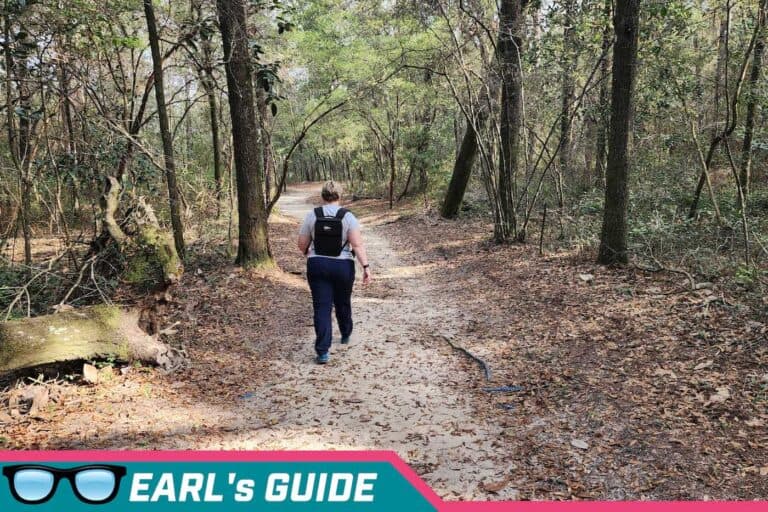You have heard of “ruck marching,” which involves walking with a weighted rucksack on your back and have heard how it’s becoming increasingly popular among more sophisticated fitness aficionados. But something is preventing you from taking the leap. You’re wondering, “Are ruck marches bad for you?”
On the one hand, you’ve probably heard how good it is for conditioning and how effective it is for fat loss. On the other hand, you’re concerned about the possibility of injury from carrying an increased weight load over extended distances.
Is rucking harmful to your health? The simple answer is no! Yet, understanding how to perform things correctly is critical if they are to be beneficial and not harmful.
What is a Ruck March?
Ruck marching, also known as rucking, is a form of physical activity that entails walking while carrying a heavy backpack. Initially utilized by the military to cover long distances carrying equipment, it has recently become a fashionable fitness trend.
Rucking stretches back to ancient times, with evidence from Greece and Rome indicating that men in military groups used to march carrying large loads. It is now used in military training to simulate battle and guarantee soldiers are physically prepared for any eventuality.
In addition to its history in warfare, rucking is becoming increasingly popular as an alternate type of training in the fitness sector. It can be done indoors or outdoors while wearing a big pack with weight plates.
Rucking has been gaining popularity in the fitness industry for some time, but it took off during the Covid-19 pandemic. Many people turned to the ruck as a fantastic outdoor exercise, seeking ways to stay in shape while maintaining social distance.
If you’re thinking about rucking, there are certain things you can do to improve your ruck march experience. This includes focusing on lowering muscle soreness and being proactive to avoid injuries.
Rucking Reduces Muscle Soreness and Injuries
Rucking might provide something unique, but it can also pose certain dangers of injury or soreness if not done correctly. However, a few critical actions can be taken to guarantee your rucking experience is as safe and fun as possible.
- Begin with a small weight and progressively increase it over time.
It is critical to begin with a small weight and gradually raise it over time. This allows your body to adjust and gives you time to build strength for greater weights. Also, choosing the correct, robust backpack, the proper distance and terrain, and wearing supportive shoes that can carry the weight load are all vital. Finally, while rucking, be aware of any indicators of soreness or exhaustion to avoid potential injuries and blisters. - Wear comfortable shoes with good arch support.
Using the proper boots or shoes while rucking is critical for avoiding damage and stiffness in your leg muscles and feet. Wear comfortable shoes with good arch support and insoles if necessary. Beginning with a lightweight backpack reduces the impact on your feet. You can progressively raise the weight as you ruck more frequently. The right backpack, as well as the right terrain and distance, can make all the difference in the world. - When rucking, use good form, such as keeping your back straight and maintaining proper posture.
Good posture is essential to optimize the benefits and minimize the risk of injury. Rucking is an excellent kind of exercise with numerous advantages. When you lean forward, maintain your back straight, engage your core, and employ a calm yet strong stride. Also, bear the weight of your hefty backpack as close to your body as possible to provide extra support for your neck and shoulders. A waist or hip belt might help you bear extra weight. - Warm up before the ruck march to help your muscles prepare for heavy lifting.
Warming up before a ruck march is critical for lowering injury risk and maximizing performance. Warming up before physical exercise helps to boost your heart rate, enhance joint mobility, and prepare your muscles for heavier weight. Use dynamic stretching and light cardio to increase your rucking performance in your warm-up regimen.
General Health Advantages of Frequent Rucking
Rucking provides numerous advantages to anyone looking for an alternative to high-impact workouts. Frequent rucking can help boost cardiac benefits, increase muscle strength, and lessen the impact of activities on joints. Furthermore, rucking is a wonderful way to build and tone muscles, enhance balance and coordination, and burn calories.
- Better cardiovascular health
Rucking raises your heart rate and keeps it there by delivering a steady kind of cardiovascular exercise. Furthermore, the weight of a rucksack increases the intensity of the workout, making it more effective in burning calories and improving overall cardiovascular health. Also, the low-impact nature of rucking is gentler on your joints while giving strenuous exercise. - Improved muscle strength and perceived exertion
Rucking not only improves cardiovascular health but also boosts muscle strength and effort. The increased weight of a rucksack raises the intensity of the workout, making it more effective at creating strong muscles and giving an intensive yet low-impact workout. - Less impact on joints than other forms of exercise
Rucking has a low impact on the body’s joints when done correctly. Some forms of exercise, such as jogging and HIIT exercises, might cause more joint injury over time due to the high-impact nature of the activity.
Rucking is an aggressive training for anyone looking for an alternative to high-impact activities.
Frequent rucking can improve cardiovascular health, develop muscle strength and endurance, and lessen the impact of activities on joints.
Furthermore, rucking is a wonderful way to build and tone muscles, enhance balance and coordination, and burn calories.
Ruck Marches vs. Other Types of Workouts
Rucking delivers many of the same training benefits as other forms of physical activity, such as running, weight training, and cycling, but it also provides unique benefits to individuals searching for a challenging workout with minimal equipment.
In this section, we’ll compare rucking to other forms of training and examine why it’s becoming a popular choice for fitness lovers worldwide.
Let’s compare rucking to some of the more popular forms of exercise:
Running
Rucking provides many of the same benefits as jogging, giving a more significant challenge and intensity. Furthermore, rucking may be done in practically any area, making it far more accessible than jogging, which frequently requires level terrain and a clear path.
Rucking also presents a distinct challenge for runners, demanding additional muscles to maintain balance, which is only sometimes essential when jogging.
Furthermore, because of the increased weight from the rucking backpack, ruck marches take more time and effort than running, making them a perfect type of exercise for people looking for a more strenuous workout.
Finally, rucking can be gentler on the joints than jogging since the extra weight absorbs some of the shocks from each stride.
Ultimately, rucking and running provide significant benefits to individuals looking to stay active. Still, rucking offers a distinct challenge and intensity that running cannot.
Cycling
Rucking and cycling are excellent kinds of exercise that provide distinct advantages to people trying to stay fit and healthy. While cycling is a terrific technique to increase cardiovascular strength and endurance, rucking adds an extra challenge owing to the rucksack’s weight.
Cycling is a low-impact form of exercise that can be done anywhere to build muscle and improve heart health.
Rucking, however, necessitates additional preparation and equipment, such as an appropriate backpack and terrain. Still, it provides distinct advantages in terms of growing strength and endurance.
HIIT workouts
Rucking and HIIT (High-intensity interval training) sessions are beneficial exercises. Rucking entails a lengthy and steady stroll or marches with a backpack laden with extra weight. HIIT workouts emphasize intense bursts of action followed by shorter recovery periods.
Both types of exercise can help you improve strength and endurance, and each has benefits based on your personal fitness goals.
HIIT workouts are ideal for anyone trying to improve their cardiovascular health and burn calories in a shorter amount of time. Rucking, however, is excellent for those looking for an intense workout that does not include high-impact actions.
Ultimately, HIIT exercises and ruck marches significantly benefit people trying to stay fit and healthy.
How to Choose the Best Rucksack for Maximum Comfort
When it comes to rucking, choosing the correct backpack is critical to having a pleasant and comfortable experience while avoiding suffering. The proper backpack should fit tightly on your back to reduce pressure on your shoulders and provide enough space for the extra weight you’ll be hauling.
Get a pack made for rucking and plenty of compartments for storing your items. Moreover, adjustable straps and a hip belt can assist you in adapting the fit for maximum comfort and avoiding rucking burns.
It is also critical to choose the proper weight for your rucksack. Many underestimate how hefty a backpack may become once it is loaded with goods. For the best comfort, consider a weight that is no more than 10-15% of your body weight.
Moreover, ensure your weight is adequately distributed between your shoulders and hips for added comfort. Increasing weight quickly and not marching at a regular walking pace might result in damage to your lower body, knees, and feet.
Rucking can be a terrific way to keep fit and healthy. Still, purchasing the correct rucksack for optimal comfort and safety is critical. With the correct equipment and a smart plan, you may reap all the benefits of a successful ruck march.
The Last Word on Whether Rucking is Good or Bad

Is rucking unhealthy for you? The answer is a loud no.
Rucking has numerous advantages, including increased strength and endurance, improved cardiovascular health, and calorie burn. Also, it is a low-impact exercise that puts less strain on the joints than running or other forms of exercise.
Nonetheless, before embarking on a long march, it is critical to recognize the potential risks connected with rucking. Choose a backpack with appropriate cushioning and adjust the straps for maximum comfort.
Moreover, choose your weight carefully and ensure it is equally spread across the pack. Finally, take frequent pauses and stay hydrated throughout your journey to optimize the benefits for your general health while minimizing any potential hazards.
To summarize, rucking is a fantastic exercise with numerous advantages. It can be a fun way to stay fit and healthy when done securely and with the proper equipment. So hit the trails to reap the benefits of a good ruck march!
Commonly Asked Questions Regarding Rucking and Ruck Marches
Q: What kind of backpack should I choose for my rucksack?
A: When choosing a backpack, ensure it fits tightly on your back and has enough room for the extra weight you’ll carry. Moreover, adjustable straps allow you to tailor the fit for maximum comfort.
Q: Is regular rucking safe?
A: When done correctly with the proper equipment and weight, rucking can be a fun way to stay active and healthy. To maximize the benefits, choose the appropriate weight for your rucksack (no more than 10-15% of your body weight) and take periodic breaks throughout your route.
Q: What are the advantages of regular rucking?
A: Rucking offers numerous advantages, including increased strength and endurance. It is an excellent cardio workout for burning calories. It is also a low-impact exercise that puts less strain on the joints. Rucking works. It has been used for years by the armed forces and green berets, and you can now benefit from this form of low-impact, strength-building exercise.

Robert Earl
Robert EarlRobert has 20+ years of experience as a Real Estate Agent, Coach, Digital Marketer & Author, coupled with a unique expertise in professional RV Park Management. His time as an RV Park Manager has been marked by a strong ability to increase campground occupancy and revenue through strategic management and targeted marketing efforts. His dual career in online marketing and RV Park Management provides a rich perspective on success in diverse fields. Robert Earl is passionate about teaching and empowering others to pursue their dreams and create sustainable income. Whether through a career in real estate, affiliate marketing, niche blogging, or transforming campgrounds into thriving communities, his proven strategies and techniques have helped numerous individuals and businesses succeed. Based on his years of experience and knowledge in the online marketing industry, along with his hands-on management in the RV Park sector, he has crafted a unique and effective approach to personal and professional growth. In addition to his business pursuits, Robert is also a CrossFit Online Level 1 Trainer (CF-OL1) and enjoys fitness activities, including Rucking workouts while traveling the country. His multifaceted career showcases his dedication to growth, innovation, and the pursuit of excellence in various domains.






